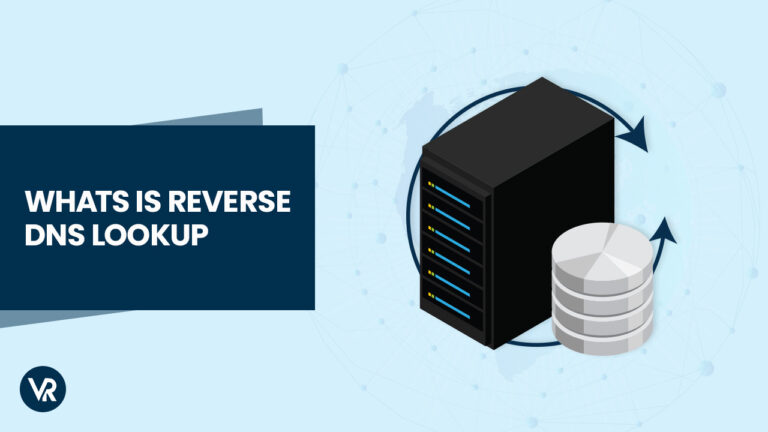
Commonly referred to as reverse IP lookup, a reverse DNS lookup is a kind of DNS lookup request that works in an opposite way of the most commonly known forward lookup request.
When you run a forward lookup command, it changes a domain name, such as www.abc.com into an IP address, such as 192.0.2.1. Whereas a reverse DNS lookup command translates an IP address into a website domain name.
Reverse DNS logs don’t necessarily need to be configured for your internet to operate normally. In fact, the forward and the reverse DNS logs don’t even require matching one another. However, if they manage to do so, this is called a forward-confirmed reverse DNS.
Reverse DNS Lookup -How does it work?
A reverse DNS lookup requests DNS servers to fetch a PTR record, also known as a Pointer Record. If the server you are connected to isn’t holding a PTR record, it cannot process a reverse DNS lookup . The PTR logs IP addresses with their parts reversed, and they add “.in-addr.arpa” to that.
Reverse DNS Lookup varies depending on the types of IP addresses . For instance, if a web domain has an IP of 192.0.2.1, it will be changed to “1.2.0.192.in-addr.arpa” using the PTR record. In IPv6 format, the most up-to-date IP routing method used for the Internet Protocol, Pointer Records are kept in the “.ip6.arpa” web domain rather than “.in-addr.arpa.”
How do you perform a reverse DNS lookup ?
There are multiple ways to perform a reverse DNS lookup. However, keeping in view the complex and special format needed to reverse DNS records, using an online tool for the said purpose is much more convenient. Such online tools automatically convert the reverse requests into a valid format.
1. Reverse DNS lookup online tool
The most convenient method of running a reverse DNS lookup command is by using a reliable online tool. All you need to do is to provide the desired IP address that you are looking to resolve and click on the lookup option.
Moreover, it will also automatically run extra forward DNS lookups on any auxiliary results which enable you to swiftly and conveniently get an understanding of all matching records obtainable.
For more ease, you can provide a domain name as well, and the automated tool will run a reverse lookup on the resulting IPs.
2. Reverse DNS lookup on Windows
Windows has an in-built tool for the DNS lookup called nslookup. This smart tool enables you to run several types of DNS lookup queries, including Pointer records for reverse DNS listing.
Fortunately, the procedure of performing reverse DNS lookups is made easier with nslookup, and it will automatically run the Pointer Record transformation into the valid “.arpa“ domain on your behalf.
3. Using the nslookup command
If you want to locate the reverse DNS record for the IP address 192.0.2.1 through the built-in DNS resolver of your Windows, run the following command:
For locating the reverse DNS record for the IP address 192.0.2.1 through the described DNS resolver 1.1.1.1, run the following command:
What are the benefits of reverse DNS records?
IP addresses are much more complex than they look. As a matter of fact, they are an IP is the most important protocol used on a Network Layer . Moreover, there are different IP Address Classes that further include a dedicated fleet of IP addresses. if you want to make a decision on best VPN with the Smart DNS check out our blog.
It is generally not required to find reverse DNS records for a particular IP address. This is usually due to the fact that the majority of DNS resolution occurs in the shape of a forward DNS lookup for converting convenient-to-remember domain names for users into numeral IP addresses for machines, however, there are a few advantages to take into consideration:
- Email deliverability: Reverse lookups are commonly used by email servers to confirm that emails are routed through servers that are assigned to send emails on a particular domain’s behalf. Email servers often deny emails coming from servers that don’t hold reverse DNS records because they are much more expected to be utilized for forwarding spam.
- Ease of identification: The majority of system administrators find it easier to catch IP addresses and reverse DNS logs in their record files to easily locate trends in internet traffic by scrutinizing domain names instead of IP addresses.
we urge you to check out our blog on Best VPN with DNS protection so you can make a secure decision for your privacy.
What Is an IP Lookup Used For?
IP lookup can reveal handy information. You can perform an IP lookup for the following details:
Located the Physical Location of an IP Address
IP lookup can reveal the physical location of a device, although it’s not fully accurate and can’t pinpoint your exact location. You can run an IP lookup to find out from where a particular IP address is operating.
If you want to hide your whereabouts while you are connected to the internet, you can use a reliable VPN, such as ExpressVPN. A VPN is designed to send your IP packet through encrypted tunnels that enhance your online security and privacy.
If you don’t have a VPN app, you can also manually change the IP address from command prompt .
Check the Legitimacy of an Email
A Pointer Record, commonly known as PTR, can be utilized to confirm whether an email is genuinely coming from a legitimate person or entity or not.
Resolve an IP Address to Hostname
The complex, numerical IP addresses aren’t designed in a way that users can remember them. That’s the reason, they are paired with more easy-to-remember names through DNS. By running an IP lookup command, you can actually get the hostname associated with a particular IP address, making it easier for you to find out which user of the website is linked to the IP in question.
Locating the ISP of a Particular IP Address
IP lookup can also give you information on the ISP to which the IP address in question is related to. In the same way, you can run an IP lookup command to get the information about your ISP as well.
FAQs: Reverse DNS Lookup
What is a reverse DNS Example ?
In reverse DNS, your IP address gets reversed with the addition of “in-addr.arpa” at the end. For example, if your IPv4 address is 67.227. 187.136, then it would become 136.187.227.67.in-addr.arpa using rDNS methodology. This method of reverse DNS resolution of an IP address uses a PTR .
Can an IP Address Reveal Your Identity ?
Yes, an IP address can reveal your identity to an extent that it provides information about your approximate physical location, your ISP name, IP domain name, IP hostname, and other crucial information .
Why do we need a reverse lookup ?
We need the reverse lookup to check the legitimacy of an IP address and to validate the internet traffic, emails, and other information sent through different machines .
Conclusion
We hope this guide will help you understand what a reverse DNS lookup is, how it works, and what it’s used for. As discussed above, a reverse DNS is sort of a DNS lookup request that works in an opposite way of the most commonly known forward lookup request. In this method, your IP address gets reversed with the addition of 136.187.227.67.in-addr.arpa at the end. This process is used to verify the legitimacy of an IP address.
For more queries and information, reach out to us in the comments section below.
